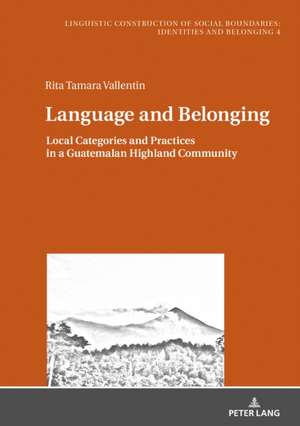Language and Belonging: Sprachliche Konstruktion sozialer Grenzen: Identitaeten und Zugehoerigkeiten / Linguistic Construction of Social Boundaries: Identities and Belonging
Autor Rita Vallentinen Limba Engleză Hardback – 19 sep 2019
Preț: 477.25 lei
Preț vechi: 619.79 lei
-23% Nou
Puncte Express: 716
Preț estimativ în valută:
91.34€ • 95.10$ • 77.19£
91.34€ • 95.10$ • 77.19£
Carte tipărită la comandă
Livrare economică 10-24 martie
Preluare comenzi: 021 569.72.76
Specificații
ISBN-13: 9783631735602
ISBN-10: 363173560X
Pagini: 296
Dimensiuni: 148 x 210 mm
Greutate: 0.67 kg
Editura: Peter Lang Copyright AG
Seria Sprachliche Konstruktion sozialer Grenzen: Identitaeten und Zugehoerigkeiten / Linguistic Construction of Social Boundaries: Identities and Belonging
ISBN-10: 363173560X
Pagini: 296
Dimensiuni: 148 x 210 mm
Greutate: 0.67 kg
Editura: Peter Lang Copyright AG
Seria Sprachliche Konstruktion sozialer Grenzen: Identitaeten und Zugehoerigkeiten / Linguistic Construction of Social Boundaries: Identities and Belonging
Notă biografică
Rita Vallentin is a researcher and lecturer at the Faculty of Cultural and Social Sciences of the European University Viadrina, Frankfurt (Oder). Working at the intersection of linguistics and sociology, she focuses on the relations of belonging and identification with linguistic practices, especially in Hispanophone and Lusophone communities.
Cuprins
Belonging and identification - Belonging and linguistic practices - Belonging as a local and interactional problem - Narrating as a local practice of belonging - Self- and other-positioning in narrative - Social and referential meanings of local adverbs - Regimes of belonging - Guatemalan rural community
Descriere
The book deals with the relationship between speakers' sense of belonging and their language use by examining their interactions in a Guatemalan community. The analysis shows that belonging is tied to the use of social, spatial and temporal categories, the relations between them, and collectively shared linguistic practices.



